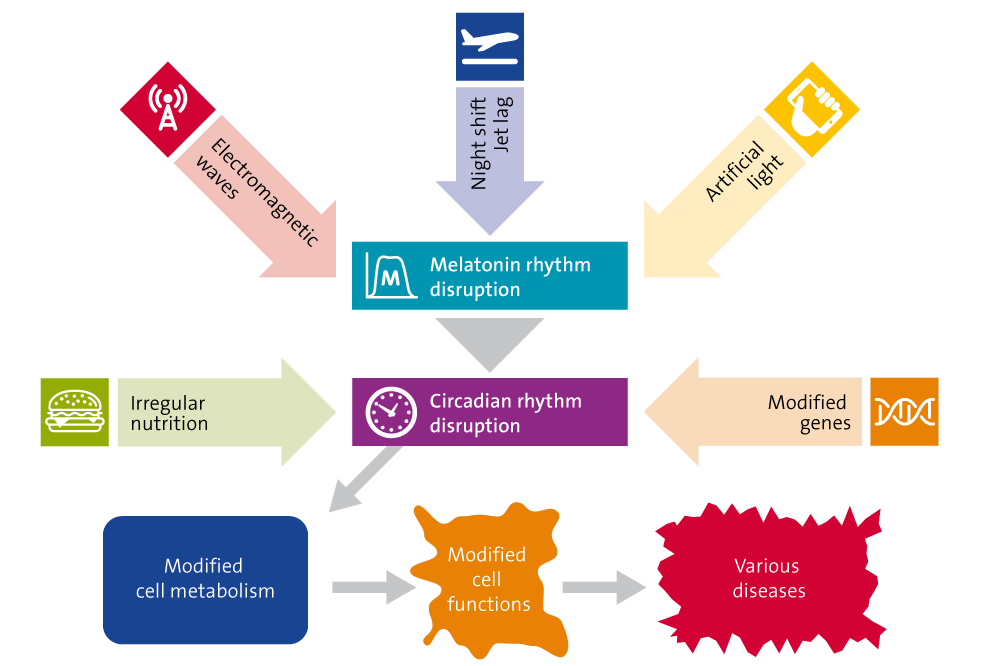Basic Facts
Medical Studies on Melatonin – Basic Facts

Melatonin (N-acetyl-5-methoxytryptamine) is mainly produced in the pineal gland, located in the brain – especially during the night in complete darkness. This is when the melatonin level rises to eight times of the level during the day. This signals to the organism that it is time for the organs and bodily functions to rest, but also to initiate vital repair mechanisms. This makes melatonin the most important internal timer.
Disruptions to cycles caused by light
On the other hand, even the slightest flash of light can affect this critical process, especially the blue light from TVs and smartphones, the light from an alarm clock or street lighting. These everyday appliances have proven to be highly disruptive to our internal cycles and have a substantially adverse impact on our melatonin balance.

Melatonin keeps our internal clock ticking
Each flash of light passes through the retina to reach the suprachiasmatic nucleus (SCN), which is connected to the pineal gland and serves as a control centre and “master clock” for the brain. Melatonin provides the timing for this internal clock, not only letting the brain know that it should switch to “night mode”, but also passing this information on to every other organ and cell in the body. If this natural mechanism is disrupted by light during the night, this has serious consequences not only for the day/night cycle, but also for the function of the organs and the development and course of many diseases.
Every cell contains melatonin
Only recently did it become known that the “powerhouses” of each cell, the mitochondria, are also capable of producing melatonin. This melatonin is not passed into the blood, but rather is used to regulate certain functions in each of the cells. This production is also partly controlled by the melatonin in the pineal gland, meaning that disorders of the pineal gland can also result in changes in how these cells function, which may result in organ damage, for example.
Medical Studies on Melatonin – Basic Facts
Last year melatonin was 60 years old, or at least its discovery was 60 years ago. The molecule itself may well be almost as old as life itself. So it is time to take yet another perspective on our understanding of its functions, effects and clinical uses.
Circadian rhythms (CR) are a series of endogenous autonomous oscillators generated by the molecular circadian clock which acting on coordinating internal time with the external environment in a 24-h daily cycle.
Melatonin (MLT), a neuromodulator mainly acting through two G-protein coupled receptors MT1 and MT2, regulates many brain functions, including circadian rhythms, mood, pain and sleep. MLT and non-selective MT1/MT2 receptor agonists are clinically used in neuropsychiatric and/or sleep disorders.
Melatonin is uncommonly effective in reducing oxidative stress under a remarkably large number of circumstances. It achieves this action via a variety of means: direct detoxification of reactive oxygen and reactive nitrogen species and indirectly by stimulating antioxidant enzymes while suppressing the activity of pro-oxidant enzymes.
Melatonin is a hormone secreted by the enigmatic pineal gland in response to darkness, hence the name hormone of darkness. It has generated a great deal of interest as a therapeutic modality for various diseases particularly sleep disorders.
Melatonin (N-acetyl-5-methoxytryptamine) is a multifunctional signaling molecule that has a variety of important functions. Numerous clinical trials have examined the therapeutic usefulness of melatonin in different fields of medicine.
During the last 20 years, numerous clinical trials have examined the therapeutic usefulness of melatonin in different fields of medicine. The objective of this article is to review, in depth, the science regarding clinical trials performed to date.
Melatonin (N-acetyl-5-methoxytryptamine) has revealed itself as an ubiquitously distributed and functionally diverse molecule. The mechanisms that control its synthesis within the pineal gland have been well characterized and the retinal and biological clock processes that modulate the circadian production of melatonin in the pineal gland are rapidly being unravelled.
Melatonin is a neurohormone produced by the pineal gland that regulates sleep and circadian functions. Melatonin also regulates inflammatory and immune processes acting as both an activator and inhibitor of these responses.
This review aims at describing the beneficial properties of melatonin related to its antioxidant effects. Oxidative stress, i.e., an imbalance between the production of reactive oxygen species and antioxidant defences, is involved in several pathological conditions such as cardiovascular or neurological disease, and in aging. Therefore, research for antioxidants has developed. However, classical antioxidants often failed to exhibit beneficial effects, especially in metabolic diseases.
Besides its well-known regulatory role on circadian rhythm, the pineal gland hormone melatonin has other biological functions and a distinct metabolism in various cell types and peripheral tissues. In different tissues and organs, melatonin has been described to act as a paracrine and also as an intracrine and autocrine agent with overall homeostatic functions and pleiotropic effects that include cell protection and prosurvival factor.
Melatonin, a widespread hormone in the animal kingdom, is produced by several organs and tissues besides the pineal gland. Whilst extrapineal melatonin behaves as a cytoprotective molecule, the pineal produces the hormone in a rhythmic manner. The discovery of melatonin in 1958, and the characterization of its synthesis somewhat later, let to the description of its photoperiodic regulation and its relationship with the biological rhythms such as the sleep/wake rhythm.
The objective of the present study was to assess the toxicology of melatonin (10 mg), administered for 28 days to 40 volunteers randomly assigned to groups receiving either melatonin (N = 30) or placebo (N = 10) in a double-blind fashion.